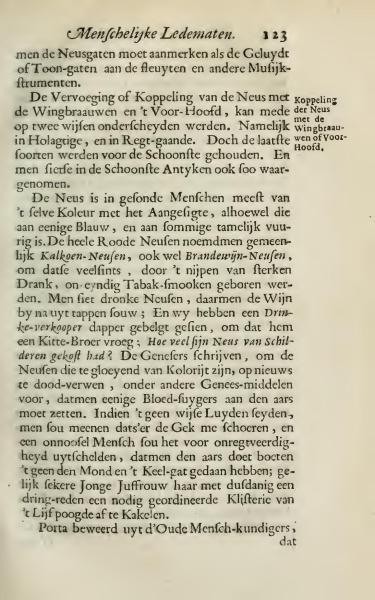Human Limbs.
One must observe the nostrils as the sound or tone holes that correspond to flutes and other musical instruments. The conjunction or connection of the nose with the eyebrows and the forehead can also be distinguished in two ways, namely concave and straight. However, the latter types were considered the most beautiful and were also found in the most beautiful antiquities.
The nose in healthy people is usually of the same color as the face, although it sometimes appears a bit blue, and in some, it is quite red. Entirely red noses are commonly called "turkey noses" or "brandy noses," as they often result from the consumption of strong drink or tobacco smoking. Drunken noses are depicted, with wine nearly pouring out; and we have seen a drink seller provocatively asked by a relative, "How much has your nose painted?" The Genevans write that to cure the noses that are too flushed with color, they recommend bloodletting around the ears among other remedies. If wise people have spoken truth, some might argue that insanity is to be shamed, and an innocent person might unjustly be accused because the ears are punished for what the mouth and throat have done; just as certain young ladies tried with great persistence to remedy a necessary enema from the body.
Porta asserted from the ancient humanities; that
Translation Notes:
Traditional terms like "turkey noses" and "brandy noses" refer to red, swollen noses often caused by heavy drinking. "Genevans" likely references the inhabitants of Geneva known for their medical theories.
This passage discusses the aesthetic aspects of the human nose, including its shape and color in relation to facial beauty standards. Red noses are humorously referred to as "turkey noses" or "brandy noses," typically attributed to alcohol consumption. The text includes medical advice from the time on treating overly red noses, as well as social commentary on how appearances can be perceived and judged.
